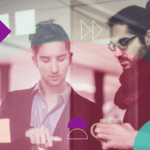By Kelly Holmstrom, VP Customer Experience Optimization at Merkle
The world of marketing, customer experiences, and data have been changing in ways that few could have predicted: pandemic restrictions, in-person business limitations, contactless experiences, and the loss of third-party cookies. Delivering the best customer experience, both online and off, is vitally important for driving business, but the environment is changing quickly.
Is the in-person customer experience up to the digital standard?
There was a time when digital was the emerging, underbuilt channel. That time has long passed, and digital channels have gotten all the attention when it comes to customer data and experiences, and it makes sense, as customer data itself is digital. But now that customer experience (CX) programs are gaining maturity in the digital world, a new focus should be placed on non-digital interactions that haven’t been integrated into the digital CX environment yet, such as the call center, bank teller, store clerk, or restaurant manager. Do they have the insights marketers are using within their powerful digital strategies to make the most of the total customer experience?
Executives generally believe their best customer experiences are digital. In fact, a recent study found that 77 percent feel they deliver a better customer experience online compared to in-person or over the phone. The level of digital dominance varies by industry, but all industries still believe digital is the best.
A lot of valuable customer information resides in digital forms, and most executives believe the majority of feedback and review data exists digitally (e.g., social 34 percent, email 31 percent, message/chat 22 percent). This is valuable preference data and should be used to improve the entire experience, including brick-and-mortar.
Customers have an expectation of continuity between their online experience and in-person service. Companies shouldn’t make customers repeat themselves when they come to the store or office. Rather, the real-time context should be captured out of the information they already provided online and use it to feed in-person agents or staff with the data and next best actions they need to take with customers when they interact with them. Especially considering that most companies believe their customers pre-shop or preview interaction decisions on the website or app before visiting a brick-and-mortar location.
For example, when a customer is picking up a buy-online-pick-up-in-store (BOPIS) order or receiving a to-go food order, there are opportunities for the clerk to upsell based on information the company has gathered in the past. The staff who meets the customer must be fed these insights and decisions at the point of interaction. Similar moments occur when a client meets with a bank teller. The teller should have the right messaging to offer the customer a new product or service based on their data.
As some experiences increasingly become contactless, there are additional data points that are gathered through the process. These data points may indicate preferences or behaviors and could be used to shape future customer experiences.
Some companies, like telco and financial services, do extensive modeling on which customers are likely to churn based on multiple indicators. When these customers call into the contact center, both the behavior of the interactive voice response (IVR) and the agent should be shaped by remedial, account-saving actions. A ready-to-churn customer is the least tolerant of a hassle and often the most expensive to lose. Similar strategies can be deployed at the cash register for retail customers and the clerks that serve them.
Decisioning is essential for CX at scale
With powerful data and hyper-personalization, we have the ability to make the customer experience seem magically easy, but only if we intentionally stitch everything together, and stitch it together at scale. The in-person staff needs to have the same data outputs that are available to digital channels. Decisioning technology is essential to this. Decisioning works from sophisticated analyses of the enterprise’s customer data and uses data science, predictive models, artificial intelligence, machine learning, rules engines, and channel activation technology to determine the next best action for each customer at each channel at the right moments. Decisioning is the only way to achieve customer experience success at scale.
The best CX strategies will elevate decisioning to the enterprise level. It’s the only way to achieve truly coordinated omnichannel customer experiences. This will require organizational cooperation and orchestration. Silos will need to be broken down. Cultures may have to be changed. While this sounds ambitious, it’s best to start decisioning on one channel, measure its success, and use that as a foundation and justification to add another channel. Then another. The long-term vision can be fulfilled with incremental change.
Rarely do such fundamental customer and operational states change so quickly as they have in the past year. As companies continue to re-envision and adapt their in-person customer experiences, they must apply the same learnings, data, and decisioning programs that have worked so well in digital spaces. Customers want to have continuity in their experiences with the companies they work with. It’s your job to make it happen.






